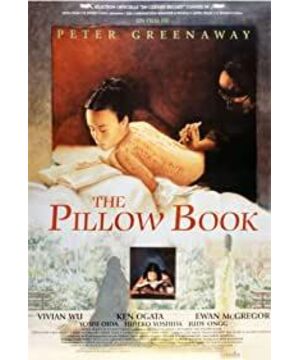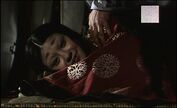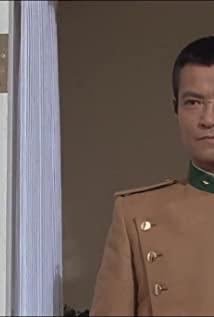In my impression, there are two famous female writers in Japan, and their works seem to be placed on one side of the Japanese literary scale, competing with other ancient and modern Japanese writers on the other side. One is "The Tale of Genji" by Shikibu. The other is "Pillow Grass" by Qing Shao Na Yan.
Peter Greenaway, the pioneer of the British trendy film, began to pay attention to him in the "Chef, Thief, His Wife and Her Lover". The scheduling in the theater space, the use of symbolic colors, Griano's costume design, and his grasp of erotic themes make him unique among many British directors. The film is about food color.
What will it be like when Greenaway meets Makiko? ! Western directors were extremely interested in Eastern themes in those years, but they found the points of fit and gave full play to their respective advantages, but not everyone could do it brilliantly. Greenaway brought this humanity to the absurdity. The revenge story is embedded in the core of the oriental theme, so that it exudes the director's unique and weird and joyful personal style. This diversified fusion and expression method reveals a unique temperament in the strangeness. No wonder it is classified by many people as the ten must-see postmodern films in the 20th century.
Besides the film itself, writing is undoubtedly the ultimate performance of this film. To be precise, it is the writing on the human body. Due to the influence of his childhood, Nuozi fell in love with being written on the body hopelessly and signed. The name of the person written on the above is that she loves "Pillow Grass" and is as sensitive as saying nothing. Growing up with the author's father, she feels that the scent of various papers is like the smell of skin, or upside down, the skin is the best for her. Good paper. Writing on the body seemed to be an addiction at first, a mere commemoration, with no other purpose or attempt. In order to commemorate her father, and to say nothing, she made friends with all kinds of lovers who made her feel the joy of writing on the body. , And those lovers are vague to her, only the satisfaction of writing at the time.
Until she met Xie Lang, a translator, when she found that Xie Lang had almost the same experience as his father many years ago (because she wanted her work to be published and had a relationship with a same-sex publisher), she met Xie Lang and met with him. In love, Xie Lang is also madly in love with body writing.
In my opinion, the turning point of the whole story has occurred. Publishers have never looked down upon works that are not good for them. In order to fulfill Nuozi’s wish to become a writer in memory of his father, Xie Lang actively proposed that Nuozi use himself as a paper. Written on his body and brought this "work" naked to the publisher... Since then, Nuozi's role has changed. Before that, she was a paper, and then she was a pen. This sentence has an obvious plot in the film. Sentences that mean transitions are unfinished.
When a body like Ivan McGregor was filled with Japanese calligraphy with a strong sense of form and meaning, I think no one could escape this temptation. The publisher agreed to publish, but out of jealousy, Noko gave up and Xie Lang’s cooperation relationship led to other men to complete her 13-volume book, but found that she finally found the ideal calligraphy lover-Xie Lang, when she walked out of the fate of being written, She fell in love... Nuozi's jealousy and dignity, contradictions and hesitation caused Xie Lang to die in love. After his death, Xie Lang's body with "Pillow Grass" was dug up from the grave by the publisher, and the human skin was removed to make a book. Such behavior is intolerable to Nuozi, she continues her thirteen books and begins her revenge plan.
Publishers can no longer tolerate the appreciation of male bodies without words, the first volume, the innocent scroll, the idiot scroll, the incompetent scroll, the exposed scroll,...the youth scroll, the secret scroll, the silent scroll, the betrayal scroll, The scroll of rebirth (the scroll of the wrong beginning) is followed by the scroll of revenge. The publisher died under the razor of hatred because of jealousy, greed and curiosity, and Nuoz got back to the "Pillow Grass" made of Shaylan skin and buried it in the plum blossoms. Later, she was 28 years old that year, and it was exactly a thousand years before Qing Shao Nayan wrote "The Pillow Grass".
The women in Greenaway's movies seem to be unable to escape the fate of revenge: the thief’s wife broke out in silence, and one shot solved the eater husband who killed her lover; Nuozi ended with the razor of the thirteenth book of revenge The publisher. Such revenge is heroic and ritual: the lover is made into a feast by the chef to force the robber to eat it; in order to get back the book made of the skin of the beloved, 13 books are planned to induce curiosity and lust. Publisher. The status of women in the film is intriguing. They move on the way of awakening and breaking out after being tamed, forbearing, and passive. The struggle is always after the tragedy. The lack of consciously active resistance makes the story always fall into a deeper and more heroic tragedy.
The characters in Greenaway's films have obvious dramatic characteristics, are excited and strong, have distinct personalities, and have a strong sense of form. His discussions in the movie are also intriguing. The food and sex in "Eros, Color, Fragrance," and the words, writing, and body in "The Pillow Forbidden Book", writing on the medium of the body, using words as the material of thought. Existence is presented on the body, a kind of imposing and a kind of looming. At the beginning, Nuozi habitually accepts men who write words on her, until she takes the initiative to choose men to write words on them to complete the plan, this attitude is consistent with The transformation of the role is present in the interchange between being written and written. The body as the medium and the text as the thought are combined seamlessly and almost perfectly in the movie.
It is also worth mentioning that the overlapping shots that appear from time to time in the film closely combine the calligraphy text with the situational image, which has an explanatory meaning. The use of picture-in-picture lenses is new and unique, presenting different fragments of the process before and after an event in the screen at the same time, or presenting the specific environment in the big screen, the environmental event in the small screen, or Realistic events are presented in the big picture, and the protagonist's association is presented in the small picture. The use of this method of expression has greatly expanded the content and breadth of the film within a certain period of time, and the unique form of expression is also eye-catching. Greenaway's pioneering nature cannot be underestimated.
View more about The Pillow Book reviews











